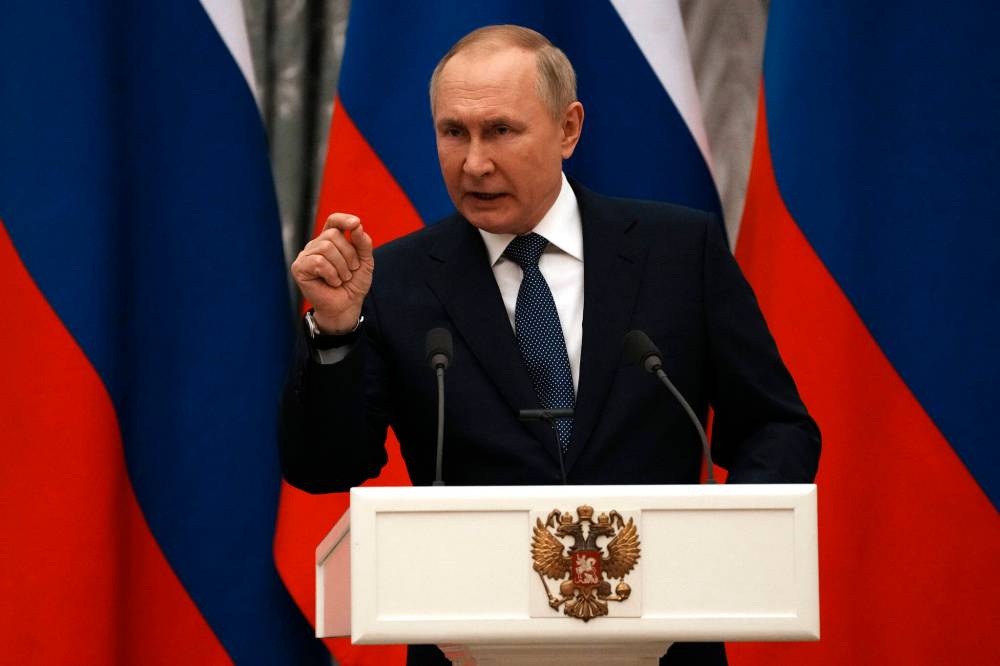On NATO issue, Putin’s made his bed
Advertisement
Read this article for free:
or
Already have an account? Log in here »
To continue reading, please subscribe:
Monthly Digital Subscription
$0 for the first 4 weeks*
- Enjoy unlimited reading on winnipegfreepress.com
- Read the E-Edition, our digital replica newspaper
- Access News Break, our award-winning app
- Play interactive puzzles
*No charge for 4 weeks then price increases to the regular rate of $19.00 plus GST every four weeks. Offer available to new and qualified returning subscribers only. Cancel any time.
Monthly Digital Subscription
$4.75/week*
- Enjoy unlimited reading on winnipegfreepress.com
- Read the E-Edition, our digital replica newspaper
- Access News Break, our award-winning app
- Play interactive puzzles
*Billed as $19 plus GST every four weeks. Cancel any time.
To continue reading, please subscribe:
Add Free Press access to your Brandon Sun subscription for only an additional
$1 for the first 4 weeks*
*Your next subscription payment will increase by $1.00 and you will be charged $16.99 plus GST for four weeks. After four weeks, your payment will increase to $23.99 plus GST every four weeks.
Read unlimited articles for free today:
or
Already have an account? Log in here »
Hey there, time traveller!
This article was published 15/07/2023 (884 days ago), so information in it may no longer be current.
After more than a year at war in Ukraine, Russian President Vladimir Putin has achieved little, but he has managed to fulfil his own prophecy.
On Tuesday, NATO officials announced that “Ukraine’s future is in NATO,” in a communique released by the 31-member nations as the alliance met for a summit in Vilnius, Lithuania. While there is no timeline set (to Ukrainian President Voldomyr Zelenskyy’s chagrin), the statement shows a clear intention to let the country into NATO’s ranks.
Prior to Russia invading Ukraine, Putin gestured toward supposed risks to Russian security should Ukraine join NATO: Zelenskyy had made entreaties to U.S. President Joe Biden to get Ukraine into the military alliance. Putin clearly feared that the alliance would expand right to his border.

AP Photo/Thibault Camus, Pool/FILE
Russian President Vladimir Putin gestures during a press conference Monday, Feb. 7, 2022 in Moscow.
Putin has a reputation for being paranoid, but in this case he wasn’t entirely off the mark; NATO, founded to counter the USSR during the Cold War, has long outlived its original reason for being. The Soviet Union collapsed in the final days of 1991 and yet NATO has not only endured, but grown far beyond its original membership. Now, a huge portion of the continent counts itself as a NATO member or at least an ally, involved through other groups, such as the Alliance with the Membership Action Plan.
While there was once co-operation between Russia and the alliance, Russia has never been a member, and ties between the two have broken down severely in the last 20 years. So while Putin deserves many criticisms, it is not unreasonable he would feel pressured as one of his neighbours sought to become part of the alliance.
There was an opportunity to make this case and perhaps merit some sympathy from those who feel NATO’s mission and reach have both been long overextended (Some critics of NATO expansion argue the alliance’s swelling ranks are a direct provocation of Russia). There was also little reason to believe Ukraine’s efforts at obtaining membership would go any better than they historically had — the country has been trying to get in since 1992, and was denied membership in 2008, with efforts to get in being rejuvenated after the 2014 Russo-Ukrainian war.
But strategies to garner sympathy, and a realistic perspective on Ukraine’s chances, were both beyond Putin’s capabilities as leader and diplomat. He chose to settle the matter with tanks instead, and so he has made Russia’s bed on the subject of NATO for a long time to come.
Prior to Feb. 24, 2022, a case could have been made that it was time to do away with NATO. The existence of an alliance that effectively opposes only one country is, arguably, contrary to the goal of a peaceful Europe in which all can work together on even terms.
But after the invasion, the point has been made. The optics tell the tale. NATO must exist, because here we are, in 2023, long after the end of the Cold War, and Russia is on the march again. And now, clearly Ukraine must be part of NATO, because they are the ones left facing the Russian assault, with less outside help than they would have received as proper members.
Despite outside support, Ukraine’s victory isn’t guaranteed: per a CNBC report, NATO Secretary General Jens Stoltenberg warned at the summit that the greatest risk of the war is a Putin victory.
But whether Putin gets what he wants from his campaign or not, he and his administration remain vilified in much of the world, and his invasion has given NATO members all the reason they could want to box him into a corner, adding as many new members as it can, guaranteeing that any Russian aggression is a provocation against the entire alliance.
Whatever becomes of Ukraine, NATO will come out of this time in history stronger than ever — and it has Putin to thank.





